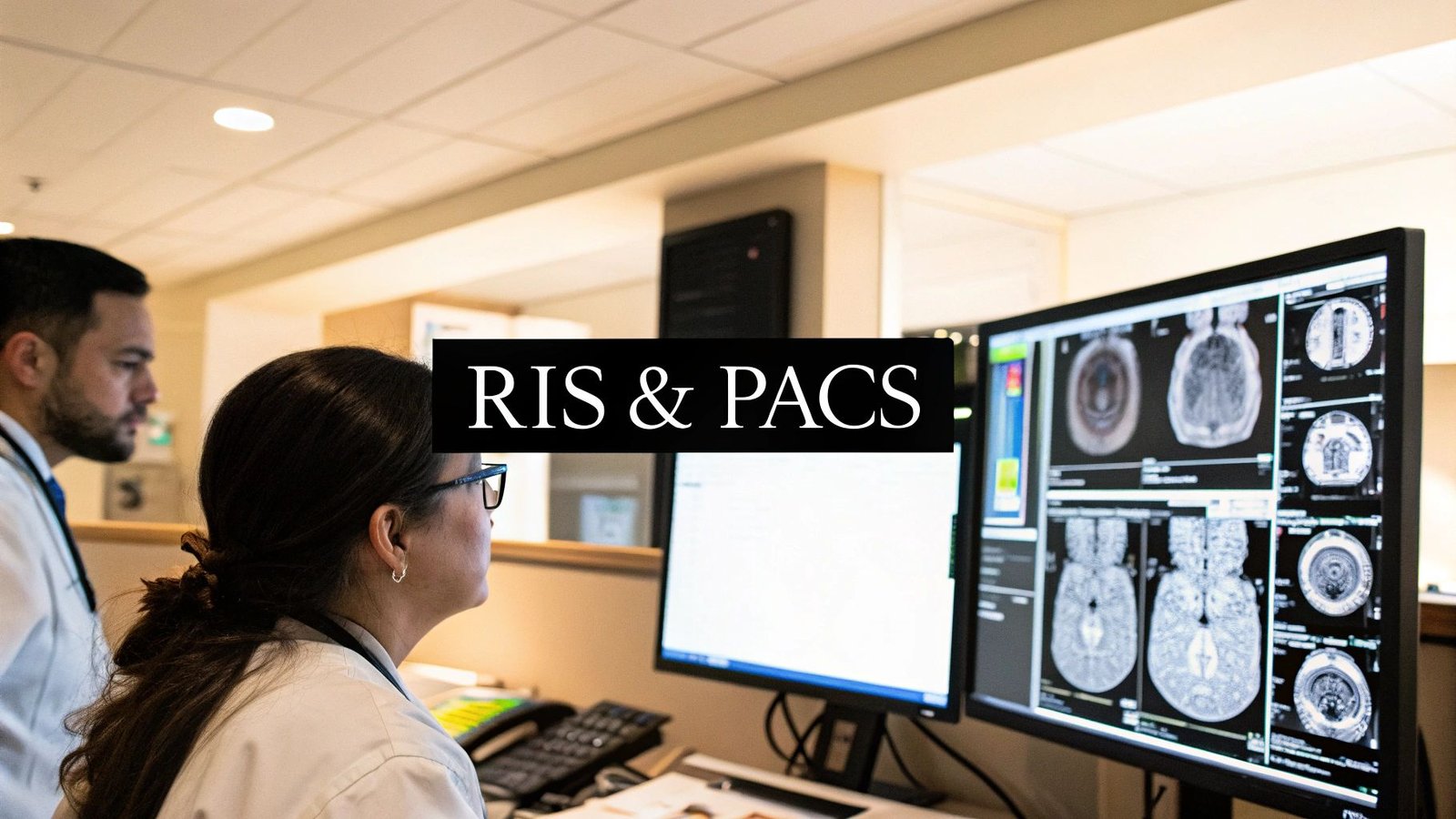Navigating the Medical Data Storage Landscape
The sheer volume of data in modern healthcare presents a significant challenge. From electronic health records and medical imaging to genomic sequencing and data from wearable devices, the amount of information generated is constantly expanding. Managing this data deluge requires robust, secure, and scalable storage solutions. These solutions must also adhere to strict regulatory frameworks like HIPAA, GDPR, and other regional requirements. Choosing the wrong solution can result in data breaches, operational bottlenecks, and hinder innovation. However, selecting the right solution can unlock the potential for improved patient care, facilitate groundbreaking research, and lead to more efficient healthcare operations.
This increase in data isn't just about storage capacity. It's also about accessibility, interoperability, and deriving actionable insights. Healthcare providers and researchers require seamless data exchange. Medical device manufacturers need secure and compliant solutions for storing and analyzing real-time device data. Finding the right storage solution can address these specific challenges and more.
This article explores the top 10 medical data storage solutions for 2025. This curated list targets medical device manufacturers, healthcare technology companies, researchers, hospital IT departments, academic institutions, medtech startups, and DICOM communication specialists.
Key Considerations For Medical Data Storage
We will examine key features, advantages, disadvantages, and pricing structures for each solution. This information will help you choose the best fit for your organization's specific needs. Factors we will analyze include:
- Scalability: Can the solution handle growing data volumes?
- Security Features: Does it offer robust encryption and access controls?
- Integration Capabilities: Can it integrate with your existing systems?
- Data Analytics Functionalities: Does it enable valuable insights from your data?
- Technical Expertise: What level of expertise is required for implementation and maintenance?
From well-established cloud providers to specialized healthcare platforms, this article offers valuable insights to navigate the complex world of medical data storage. By understanding the current landscape, organizations can effectively manage current and future data demands.
1. Amazon Web Services (AWS) Healthcare
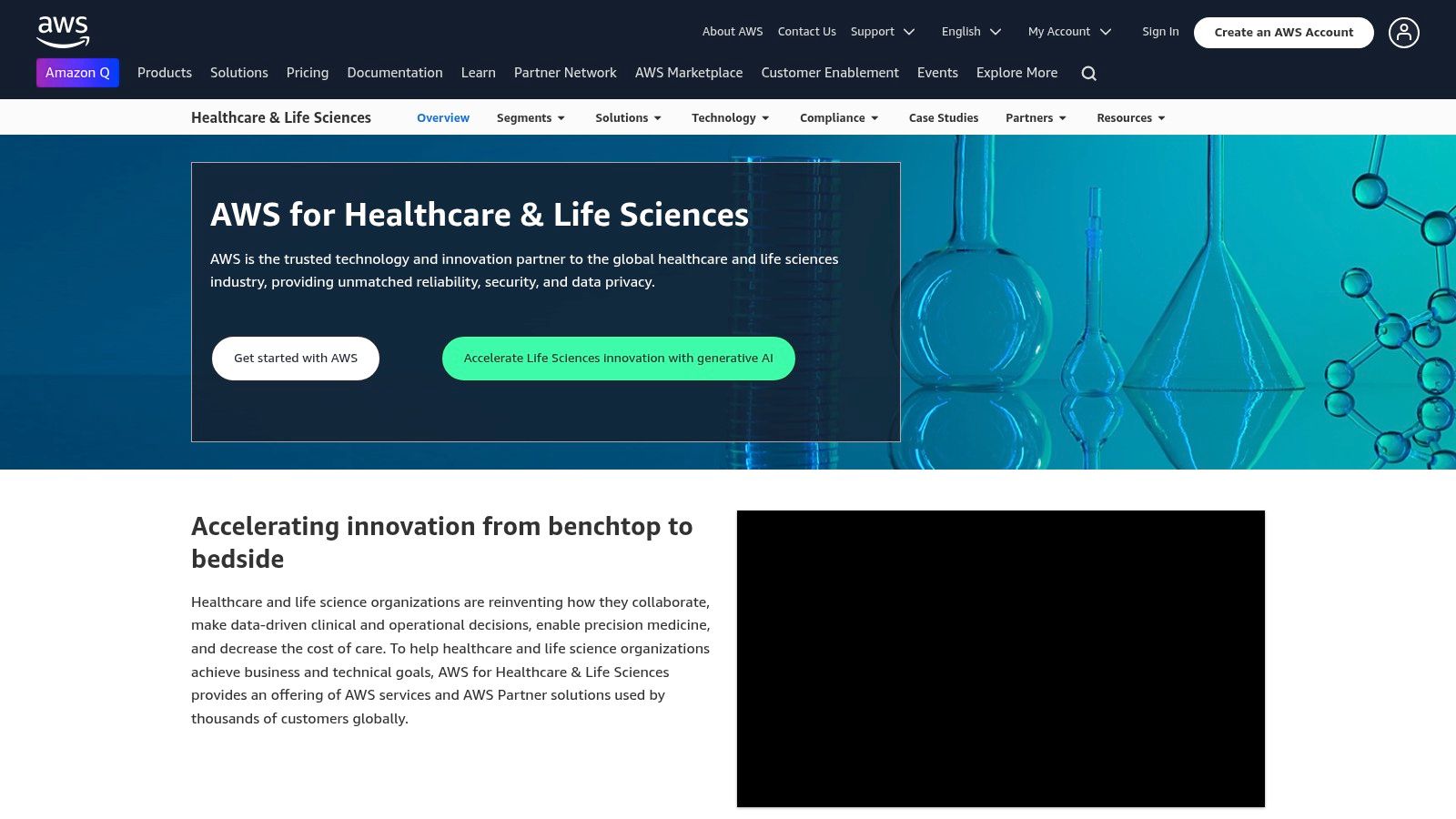
Amazon Web Services (AWS) Healthcare provides a robust suite of HIPAA-eligible cloud services designed for the healthcare industry. Its comprehensive features, scalability, and security controls address the specific needs of medical data management. Whether you need to store petabytes of medical imaging data or enable complex analytics and genomics research, AWS offers a compelling solution for organizations seeking secure and flexible medical data storage.
Practical Applications and Use Cases:
-
Medical Imaging Storage and Analysis: AWS can store and analyze massive volumes of DICOM and non-DICOM medical image data. This allows for efficient retrieval and advanced image processing for diagnostics, research, and AI-driven applications. This is especially useful for medical device manufacturers developing imaging solutions and academic institutions conducting research.
-
Genomics Research: The scalability and computing power of AWS make it well-suited for genomic data storage and analysis. This can accelerate research timelines and empower personalized medicine initiatives.
-
Clinical Information Systems: AWS can host and manage electronic health records (EHR) and other clinical information systems. This provides secure access for authorized personnel and supports interoperability between healthcare providers.
-
MedTech Startups: AWS offers a cost-effective and scalable platform for medtech startups to build and deploy healthcare solutions, utilizing cloud-based infrastructure without large upfront investments.
-
DICOM Communication and Transfer Companies: Using services like Amazon S3 and AWS Transfer Family, companies specializing in DICOM communication can securely store, transfer, and manage substantial volumes of DICOM files, improving workflows and ensuring compliance.
Features and Benefits:
-
HIPAA-Eligible Cloud Storage: Data is encrypted both at rest and in transit, ensuring the privacy and security of sensitive medical information.
-
Scalable Architecture: AWS can handle petabytes of data, accommodating the increasing demands of medical imaging, genomics, and other data-intensive applications.
-
Healthcare-Specific Machine Learning and Analytics: AWS provides pre-trained models and tools for medical image analysis, drug discovery, and other healthcare-specific analytics tasks.
-
Comprehensive Access Controls and Audit Logging: Granular control over data access and detailed audit trails help ensure compliance and security.
-
Global Infrastructure with High Availability and Disaster Recovery Options: Multiple availability zones and regions offer redundancy and resilience against outages.
Pros:
-
Extensive Ecosystem: Integration with a wide array of AWS services and third-party tools provides flexibility and customization.
-
Pay-as-you-go Pricing: Eliminates large initial costs and allows organizations to scale their usage as needed.
-
Robust Security Controls: Meets stringent healthcare compliance requirements, including HIPAA.
-
Global Infrastructure: Data residency options allow organizations to comply with regional data privacy regulations.
Cons:
-
Complex Pricing: The pay-as-you-go model can be difficult to predict and manage, particularly for large datasets.
-
Requires Cloud Expertise: Proper configuration and ongoing maintenance require specialized cloud knowledge.
-
Data Transfer Costs: Transferring large datasets to and from AWS can be expensive.
-
Potential Vendor Lock-in: Relying on AWS services can create vendor lock-in.
Implementation/Setup Tips:
-
Start Small and Scale: Begin with a pilot project to test and validate your AWS setup before migrating larger datasets.
-
Leverage AWS Professional Services: Engage AWS experts to help with architecture design, implementation, and optimization.
-
Carefully Plan Data Migration: Create a comprehensive data migration strategy to minimize downtime and costs.
-
Monitor Costs Closely: Use AWS cost management tools to track and optimize cloud spending.
Website: https://aws.amazon.com/health/
AWS Healthcare is a powerful and flexible solution for organizations looking to utilize the cloud for medical data storage and analysis. However, careful planning and cloud expertise are vital for maximizing its benefits and minimizing potential downsides.
2. Microsoft Azure Healthcare APIs
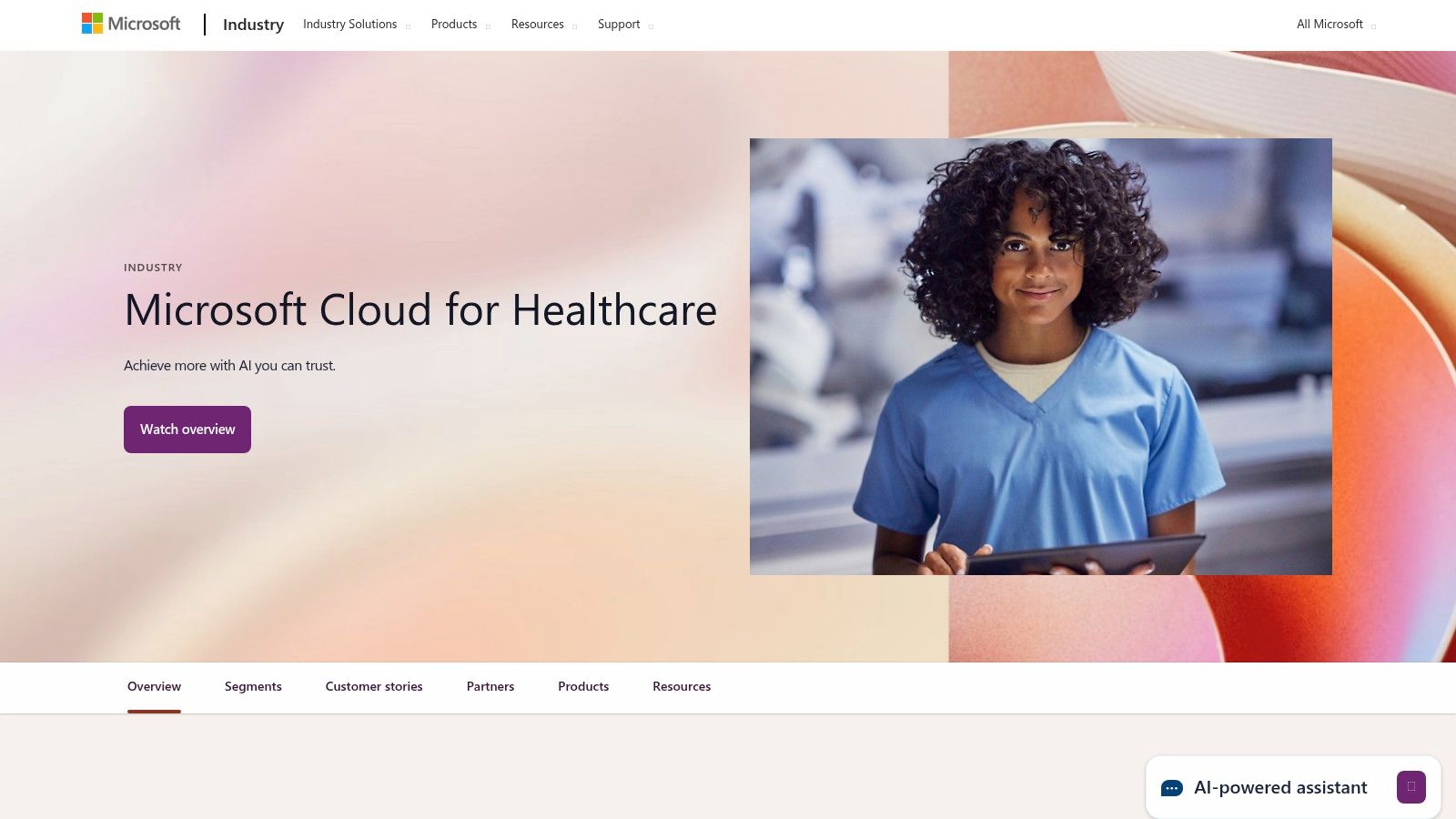
Microsoft Azure Healthcare APIs offer a powerful and adaptable platform for handling and interpreting healthcare data. This makes it a valuable asset for a wide array of organizations, from medical device companies to research facilities. Its main strength is its commitment to industry standards like FHIR and DICOM, which allow for seamless integration and data sharing between diverse healthcare systems. This interoperability is key in today's healthcare environment, where connected systems and data sharing are increasingly important for better patient care and research.
Practical Applications and Use Cases
-
Medical Device Integration: Device manufacturers can use Azure Healthcare APIs to securely gather and analyze data from connected devices. This enables real-time monitoring, predictive maintenance, and tailored treatment plans.
-
Clinical Data Management: Hospitals and clinics can use FHIR services to manage electronic health records (EHRs). This streamlines administrative tasks and simplifies data exchange with other providers.
-
Medical Imaging and Diagnostics: DICOM services on Azure provide a scalable and secure platform for storing, managing, and sharing medical images. This facilitates quicker diagnoses and easier collaboration among specialists. It's particularly valuable for academic institutions and medtech startups specializing in medical imaging.
-
Medical Research and Development: Researchers can leverage Azure Healthcare APIs to access and analyze large, de-identified patient datasets. This accelerates the development of new treatments and diagnostic methods. Support for DICOM and FHIR helps standardize and combine data from various sources.
-
Telehealth Platforms: Incorporating Azure Healthcare APIs into telehealth platforms ensures secure data transfer between patients and healthcare professionals. This supports remote monitoring, virtual appointments, and personalized care delivery.
Features and Benefits
-
FHIR and DICOM Support: These standards ensure consistent data exchange and compatibility across different healthcare systems.
-
Advanced Search Capabilities: The Azure API for FHIR provides powerful search features, enabling researchers and clinicians to quickly locate specific patient data.
-
Integration with Microsoft Ecosystem: Azure Healthcare APIs seamlessly integrate with other Microsoft tools like Microsoft 365 and Microsoft Teams, boosting collaboration and communication within healthcare settings.
-
Robust Security and Compliance: End-to-end encryption and advanced threat protection guarantee data security and compliance with HIPAA, GDPR, HITRUST, and other regulations. Maintaining patient privacy and adhering to regulatory guidelines are vital.
Pros and Cons
A quick overview of the advantages and disadvantages highlights key considerations:
| Pros | Cons |
|---|---|
| Comprehensive Interoperability | Microsoft Ecosystem Dependence |
| Robust Security and Compliance | Cost (premium features can be expensive) |
| Scalability and Reliability | Complex Licensing Structure |
| Advanced Analytics Capabilities | Learning Curve (requires technical expertise) |
Pricing and Technical Requirements
Azure Healthcare APIs pricing is consumption-based and depends on the services used. Check the Azure website for specific pricing details. Technical requirements include familiarity with Azure cloud services, FHIR and DICOM standards, and programming languages like C# or Python.
Implementation Tips
-
Pilot Project: Start small with a pilot project to test and refine the solution before widespread deployment.
-
Leverage Existing Infrastructure: Utilize existing Microsoft infrastructure and expertise if possible.
-
Consult with Experts: Seek guidance from Azure specialists regarding architecture, security, and compliance.
-
Evaluate Pricing: Carefully consider pricing and licensing choices to optimize cost-effectiveness.
Website: https://azure.microsoft.com/en-us/industries/healthcare/
Microsoft Azure Healthcare APIs are a valuable resource because of the comprehensive services tailored specifically for the intricate world of healthcare data. While there might be a learning curve and potentially higher costs, the strong security, adherence to industry standards, and integration with the broader Microsoft ecosystem make it a robust option. Organizations looking for a scalable and compliant platform to manage and analyze medical data will find this particularly compelling. The strengths in DICOM and FHIR support are especially attractive for those involved with medical imaging, research, and system interoperability. For organizations already utilizing the Microsoft ecosystem, the integration benefits are especially advantageous.
3. Google Cloud Healthcare API
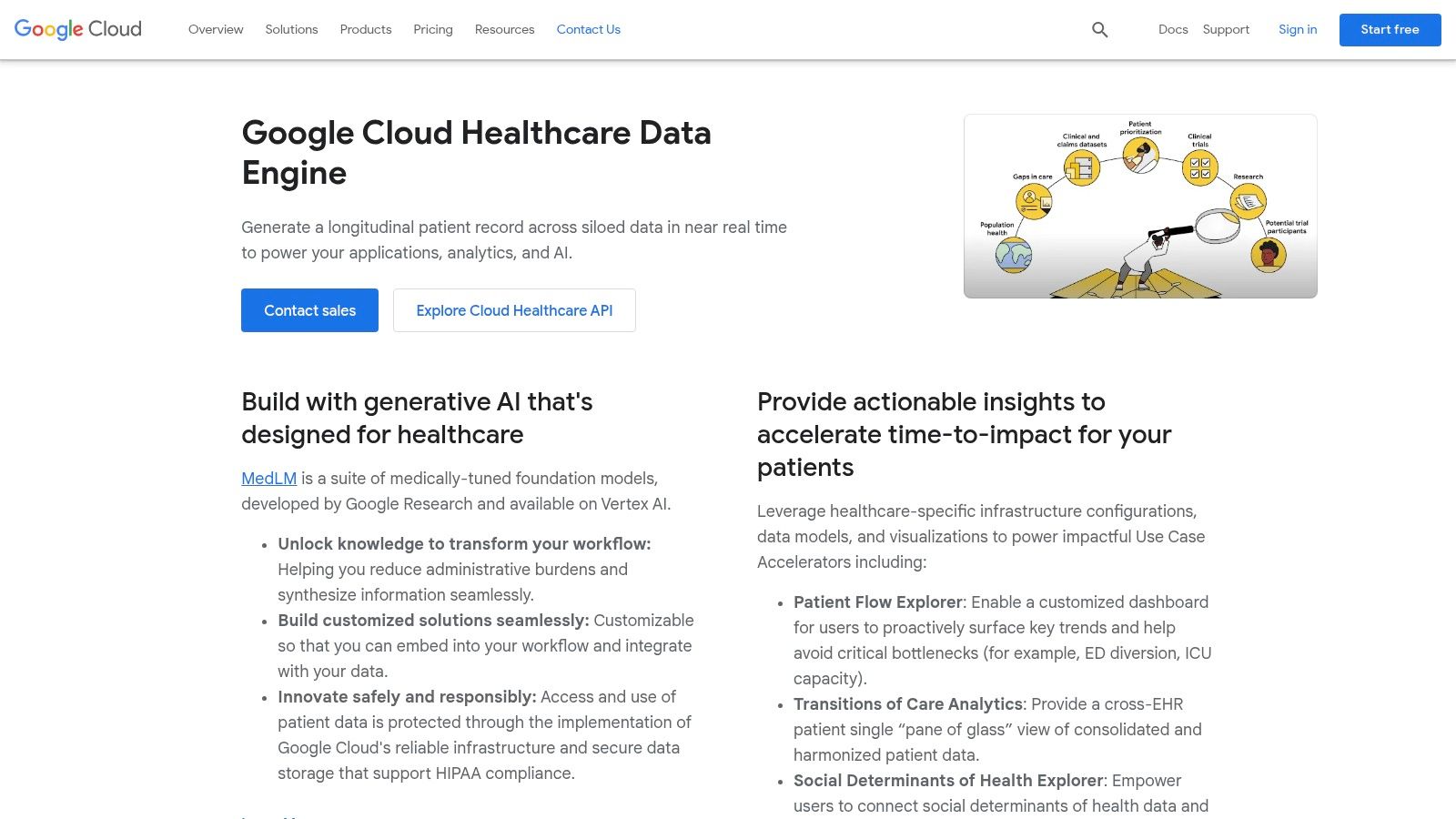
The Google Cloud Healthcare API is a valuable tool for managing and analyzing healthcare data. Its strength lies in its ability to handle this sensitive information within the secure Google Cloud environment. Designed to meet the complex needs of organizations dealing with protected health information (PHI), it offers robust features for interoperability, analytics, and AI-driven insights.
This makes it an attractive option for a wide range of healthcare stakeholders. These include medical device manufacturers, healthcare technology companies, researchers, and hospital systems looking to innovate using cloud computing.
Description
The Google Cloud Healthcare API provides a managed solution for storing and accessing healthcare data in Google Cloud. It offers a suite of APIs that connect existing healthcare systems and support FHIR, HL7v2, and DICOM formats. This allows organizations to ingest, store, analyze, and integrate healthcare data securely. Furthermore, it enables them to leverage Google's advanced AI and machine learning capabilities.
Key Features and Benefits
-
Structured Storage for Diverse Data Formats: Supporting FHIR, HL7v2, and DICOM allows the platform to handle a wide array of healthcare data. This ranges from electronic health records to medical imaging, ensuring crucial interoperability for modern healthcare systems.
-
De-identification and Consent Management: Built-in tools help organizations comply with privacy regulations, such as HIPAA. These tools facilitate data de-identification and manage patient consent for data usage.
-
Seamless Integration with BigQuery: Healthcare data can be easily analyzed using BigQuery, Google's powerful data warehouse. This enables complex queries and reporting for research, operational improvements, and public health initiatives.
-
AI and Machine Learning with Vertex AI: Integration with Vertex AI allows users to utilize pre-trained models. They can also build custom machine learning models for tasks like disease prediction, personalized medicine, and drug discovery.
-
Robust Security and Compliance: Google Cloud’s robust security infrastructure provides fine-grained access management and encryption. This assists organizations in maintaining HIPAA compliance and data security.
Use Cases
-
Medical Device Manufacturers: Streamline data ingestion from connected devices and analyze device performance data for research and development.
-
Healthcare Technology Companies: Build innovative healthcare applications by leveraging FHIR interoperability and Google’s AI capabilities.
-
Medical Researchers and Scientists: Analyze large datasets of patient records and medical images to accelerate research and discovery.
-
Hospital and Clinic IT Departments: Modernize legacy systems and improve data exchange between departments and with external partners.
-
Academic Institutions: Facilitate medical imaging research, training, and collaboration.
-
MedTech Startups: Develop and deploy scalable healthcare solutions quickly and securely.
-
DICOM Communication & Transfer Companies: Enhance DICOM workflows and integrate with cloud-based image analysis tools.
Pricing, Technical Requirements, and Comparison
Google Cloud Healthcare API pricing is based on data storage volume and the number of API calls. Details are available on the Google Cloud pricing page. A Google Cloud project and familiarity with Google Cloud services are required to use the API. Developers will also need to understand relevant healthcare data standards (FHIR, HL7v2, DICOM).
While AWS and Azure offer similar healthcare cloud solutions, Google Cloud differentiates itself through its integration with BigQuery and Vertex AI. This offers powerful analytics and machine learning opportunities. However, AWS and Azure currently have larger healthcare-specific partner ecosystems and potentially more extensive compliance documentation.
Implementation Tips
-
Begin with a well-defined use case and data integration strategy.
-
Consult the available API documentation and code samples.
-
Consider Google Cloud’s Professional Services for implementation and integration support.
Pros and Cons
Pros:
- Strong support for healthcare interoperability standards
- Advanced analytics and AI capabilities
- Scalable infrastructure
- Comprehensive security and compliance controls
Cons:
- Smaller healthcare-specific partner ecosystem compared to competitors
- Potentially less extensive healthcare compliance documentation
- Learning curve for organizations new to Google Cloud
- Potential data usage concerns
Website
https://cloud.google.com/healthcare
4. IBM Watson Health
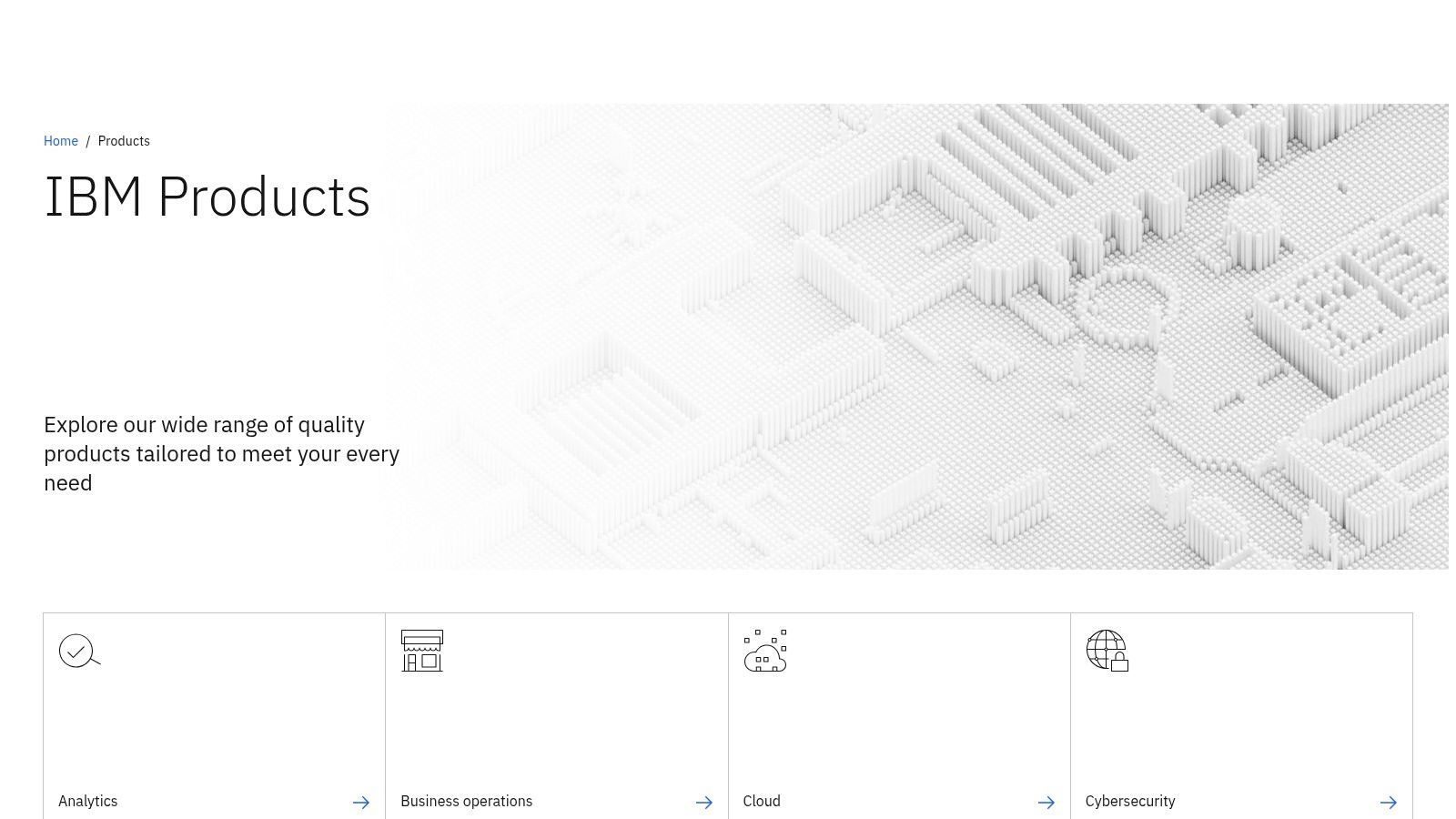
IBM Watson Health provides a suite of enterprise-grade solutions designed for storing, analyzing, and interpreting medical data. Built on the IBM Cloud and infused with Watson's AI capabilities, it addresses various needs, from secure data storage to advanced analytics. This makes it an attractive option for organizations seeking actionable insights from their medical data. Its comprehensive features, powerful analytics, and focus on healthcare make it a notable platform.
Key Features and Benefits:
-
Enterprise-Grade Medical Data Lake Architecture: This architecture enables centralized storage and management of diverse data, including clinical, imaging (with DICOM support), and genomic data. It offers a unified view of patient information, valuable for medical device manufacturers and medtech startups looking to integrate data from various devices and systems.
-
AI-Powered Data Analytics and Insights: Watson's cognitive abilities power advanced analytics, identifying patterns, predicting trends, and generating insights. This can improve diagnostics, treatment planning, and research efforts. Medical researchers and scientists can use these capabilities for complex data analysis and hypothesis testing.
-
Integrated Medical Imaging Storage and Analysis: Supporting DICOM and other healthcare standards, IBM Watson Health offers specialized solutions for managing and analyzing medical images. This is particularly useful for academic institutions and companies specializing in medical imaging. DICOM communication and transfer companies can benefit from improved workflows and interoperability.
-
Support for FHIR and Other Healthcare Standards: Adherence to industry standards, including FHIR, ensures interoperability and smooth data exchange with other healthcare systems. This is essential for hospital and clinic IT departments needing integrated solutions.
-
Hybrid Cloud Deployment Options: The platform offers deployment flexibility, including on-premises, cloud, and hybrid models. This allows organizations to choose the best fit for their infrastructure and security needs.
Use Cases
-
Developing AI-Powered Diagnostic Tools: Medical device manufacturers can use Watson's AI capabilities to create diagnostic tools that analyze medical images and patient data for early disease detection.
-
Accelerating Drug Discovery: Pharmaceutical companies and researchers can utilize Watson's analytical power to analyze genomic and clinical data, identify potential drug targets, and speed up the drug discovery process.
-
Improving Patient Care: Hospitals and clinics can use Watson Health to analyze patient data, identify at-risk individuals, personalize treatment plans, and improve patient outcomes.
-
Facilitating Medical Research: Academic institutions and research organizations can leverage the platform to store, manage, and analyze large datasets, furthering medical research.
Pros
-
Deep Healthcare Domain Expertise and Established Industry Presence: IBM's long history in healthcare brings a level of trust and experience.
-
Advanced AI Capabilities Specifically Trained on Healthcare Data: Watson's AI offers distinct advantages in analyzing complex medical data.
-
Comprehensive Security and Compliance Frameworks: Data security is a priority for IBM Watson Health.
-
Flexible Deployment Options: The platform caters to different organizational needs and existing infrastructures.
Cons
-
Generally Higher Cost Compared to Pure Cloud Solutions: Enterprise-grade features often come with a higher price tag.
-
Integration Complexity with Existing Infrastructure: Implementing a comprehensive solution like this can present challenges.
-
Can Require Significant Professional Services Engagement: Expert assistance may be necessary for setup and customization.
-
Some Solutions Have Steep Learning Curves: Mastering the advanced features can require time and training.
Pricing and Technical Requirements
Pricing for IBM Watson Health solutions varies depending on the specific products and services. Contact IBM sales representatives for detailed pricing information. Technical requirements also depend on the chosen solutions and deployment model. Consult IBM's documentation and support resources for specific details.
Implementation/Setup Tips
-
Clearly Define Your Objectives and Requirements: Before implementation, identify the specific problems you want to solve and the necessary data.
-
Engage with IBM Experts: Leverage IBM's professional services for implementation, customization, and training guidance.
-
Pilot the Solution: Start with a small pilot project to test the system and refine your approach before full deployment.
Website: https://www.ibm.com/watson-health
5. Salesforce Health Cloud
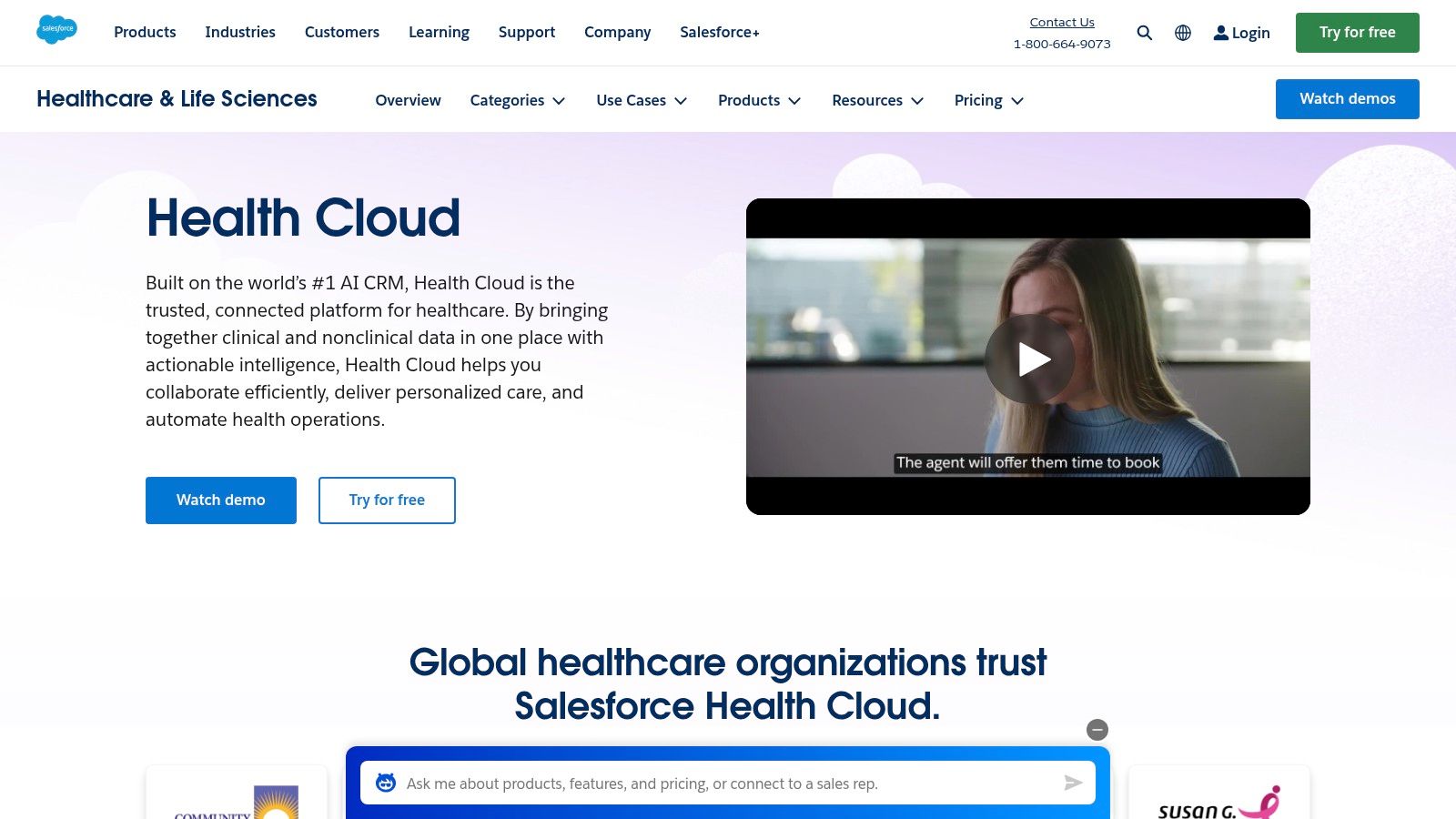
Salesforce Health Cloud is a powerful patient relationship management (PRM) platform with impressive medical data storage capabilities. While not exclusively a data storage solution, its emphasis on patient-centric data organization and easy access makes it valuable for organizations focused on patient engagement and personalized care. This is particularly relevant for medical device manufacturers, healthcare technology companies, and research institutions seeking to better understand patients.
Salesforce Health Cloud creates a unified view of each patient. It combines clinical data (diagnoses, medications, lab results) with non-clinical information (demographics, communication preferences, social determinants of health). This 360-degree view uses a patient-centered data model. This allows providers and researchers to better understand individual patient needs and tailor interventions for improved outcomes. Features like care gap identification and health timeline visualization further enhance this understanding and promote proactive care.
Key Features and Benefits
-
Patient-Centered Data Model with 360-Degree View: Medical device manufacturers can gain insights into product usage, healthcare technology companies can build integrated applications, and researchers can conduct more comprehensive studies.
-
Care Gap Identification and Health Timeline Visualization: Researchers can identify data trends, and medtech startups can develop targeted interventions. This visual approach helps pinpoint areas where care may be lacking.
-
Integration with EHR Systems through FHIR and HL7: This is crucial for seamless data exchange and interoperability. It allows for the incorporation of data from various sources, enriching patient profiles. This feature is particularly valuable for hospital IT departments and those working with DICOM communication.
-
HIPAA-Compliant Communication Tools: Secure and compliant communication is essential for handling sensitive patient data. This feature protects patient privacy and ensures regulatory compliance.
-
Customizable with AppExchange Healthcare Solutions: Organizations can tailor the platform to their specific needs. This is beneficial for academic institutions with niche research areas or medical device manufacturers with unique data requirements. Salesforce AppExchange offers a wide range of healthcare solutions.
-
Powerful Reporting and Analytics Capabilities: The platform provides insights into patient populations, treatment effectiveness, and operational efficiency. This information is essential for research, product development, and strategic planning.
Pros
- Intuitive user interface requiring minimal training
- Strong patient engagement and relationship management tools
- Robust ecosystem of healthcare-specific applications
- Powerful reporting and analytics
Cons
- More focused on CRM than pure clinical data storage
- Higher per-user licensing costs compared to some alternatives (contact Salesforce for specific pricing)
- May require customization for specialized clinical workflows
- Can be challenging to integrate with legacy healthcare systems
Implementation/Setup Tips
- Define your data needs and workflows before implementation.
- Consider Salesforce's professional services or certified partners for complex integration projects.
- Explore pre-built solutions on the AppExchange to accelerate implementation.
- Prioritize user training for optimal adoption and utilization.
Comparison with Similar Tools
Salesforce Health Cloud differentiates itself through its comprehensive PRM capabilities, unlike dedicated clinical data repositories. It complements pure storage solutions by enhancing patient engagement and data accessibility. This makes it different from tools like InterSystems IRIS for Health, focused on data management, or Epic’s Cosmos, designed for large healthcare systems.
Website: https://www.salesforce.com/solutions/industries/healthcare/health-cloud/
Salesforce Health Cloud is a valuable tool for organizations looking to improve patient engagement, streamline care coordination, and develop a more holistic understanding of their patients. While it might not be ideal for organizations solely focused on bulk clinical data storage, its PRM capabilities and extensive app ecosystem are significant strengths. Its potential for customization and integration allows it to adapt to evolving organizational needs.
6. Oracle Health
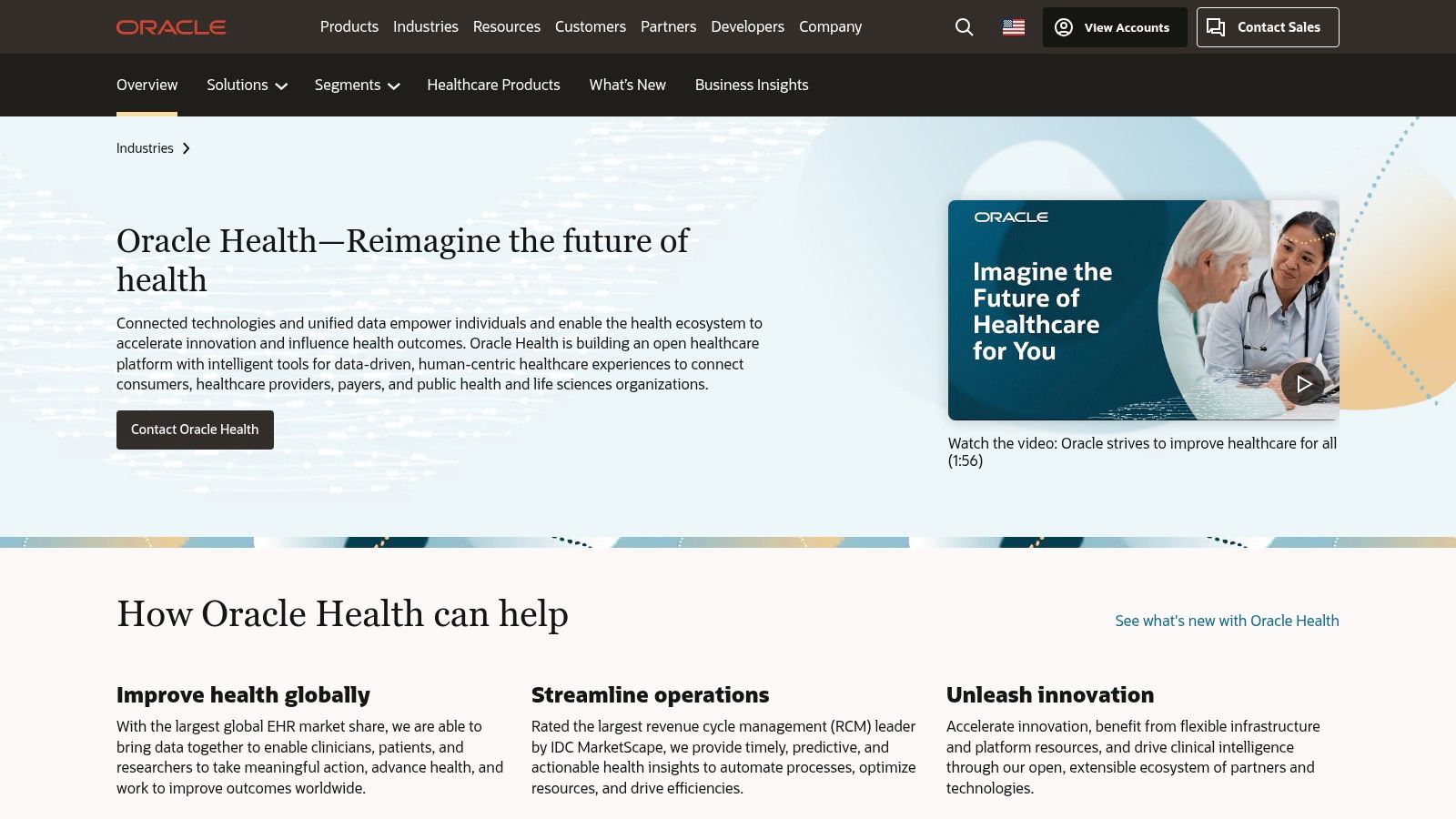
Oracle Health (formerly Cerner) offers a comprehensive suite of solutions for storing medical data. These solutions are tightly integrated with their well-known electronic health record (EHR) systems. This integration makes Oracle Health an attractive option for large healthcare systems already using Cerner's EHR.
The platform handles a wide variety of data, including clinical data, medical images (like DICOM files), and genomic information. It also offers robust analytics while prioritizing regulatory compliance (HIPAA, GDPR) and interoperability within healthcare ecosystems. This makes Oracle Health a powerful, though potentially complex, solution for organizations looking for a deeply integrated approach to data management.
Key Features and Benefits
-
Integrated EHR and Clinical Data Repository: This seamless data flow between clinical workflows and the data repository simplifies data access for clinicians and researchers. It minimizes data silos and promotes data consistency.
-
Centralized Medical Imaging Archive with Viewer: Oracle Health provides a central repository for all medical images, including DICOM files. A built-in viewer simplifies image management and access for radiologists and other clinicians. This feature is essential for medical device manufacturers, medtech startups, and academic institutions working with medical imaging.
-
Healthcare-Specific Data Warehousing Solution: The purpose-built data warehouse, optimized for healthcare data, enables complex analyses for research, quality improvement, and operational efficiency.
-
Real-Time Analytics and Clinical Decision Support: Clinicians gain real-time insights at the point of care to support informed decision-making and potentially improve patient outcomes.
-
Comprehensive Privacy and Security Controls: Robust security measures ensure data integrity and confidentiality, which are vital for maintaining compliance and patient trust.
Practical Applications and Use Cases
-
Large Hospital Systems: Managing and analyzing patient data across multiple departments and facilities.
-
Medical Research Institutions: Conducting large-scale clinical trials and genomic studies.
-
Medical Device Manufacturers: Integrating device data with patient records for performance monitoring and research.
-
Healthcare Technology Companies: Developing data-driven applications and services.
-
Academic Institutions: Supporting medical education and research initiatives.
-
DICOM Communication and Transfer Companies: Leveraging the integrated imaging archive for streamlined workflows.
Pros
-
Deep integration with clinical workflows: Reduces data silos and improves data accessibility.
-
Strong healthcare domain expertise and industry presence: Oracle Health benefits from Cerner's long-standing experience in the healthcare sector.
-
Enterprise-grade reliability and performance: Designed for the demands of healthcare environments.
-
End-to-end solution minimizing integration challenges: Streamlines implementation and reduces reliance on multiple vendors.
Cons
-
Higher total cost of ownership compared to cloud-native options: Consider the significant upfront investment and ongoing maintenance costs.
-
Complex implementation requiring significant resources: Requires dedicated IT staff and extensive planning.
-
Less flexibility for custom use cases outside standard offerings: May limit customization options for specific research or operational needs.
-
Potential vendor lock-in concerns: Tight integration can make it difficult to switch vendors later.
Pricing and Technical Requirements
Pricing for Oracle Health solutions typically depends on factors like the number of users, modules implemented, and data storage needs. Contact Oracle Health directly for specific pricing details. Technical requirements vary depending on the specific modules and deployment model. Implementing Oracle Health often requires substantial IT infrastructure and expertise.
Comparison with Similar Tools
While Epic and Meditech offer similar integrated EHR and data storage solutions, Oracle Health (Cerner) focuses on enterprise-grade scalability, comprehensive imaging capabilities, and robust analytics tools. Cloud-native solutions like Google Cloud Healthcare API and AWS for Health offer greater flexibility and potentially lower costs but may require more integration effort.
Implementation/Setup Tips
-
Engage with Oracle Health early in the planning process: Their team can provide valuable guidance and support.
-
Conduct a thorough needs assessment: Identify specific data storage and analytics requirements.
-
Allocate sufficient resources for implementation and training: A dedicated project team and comprehensive training are essential.
-
Develop a clear data migration strategy: Plan for migrating existing data to the new platform.
Website: https://www.oracle.com/industries/healthcare/
Oracle Health earns its place on this list because of its comprehensive, integrated approach to medical data storage. While the cost and complexity can be substantial, its robust features, strong healthcare focus, and enterprise-grade reliability make it a good option for organizations wanting a fully integrated solution. It's particularly relevant for larger institutions already working within the Cerner ecosystem.
7. Dell EMC PowerScale for Healthcare
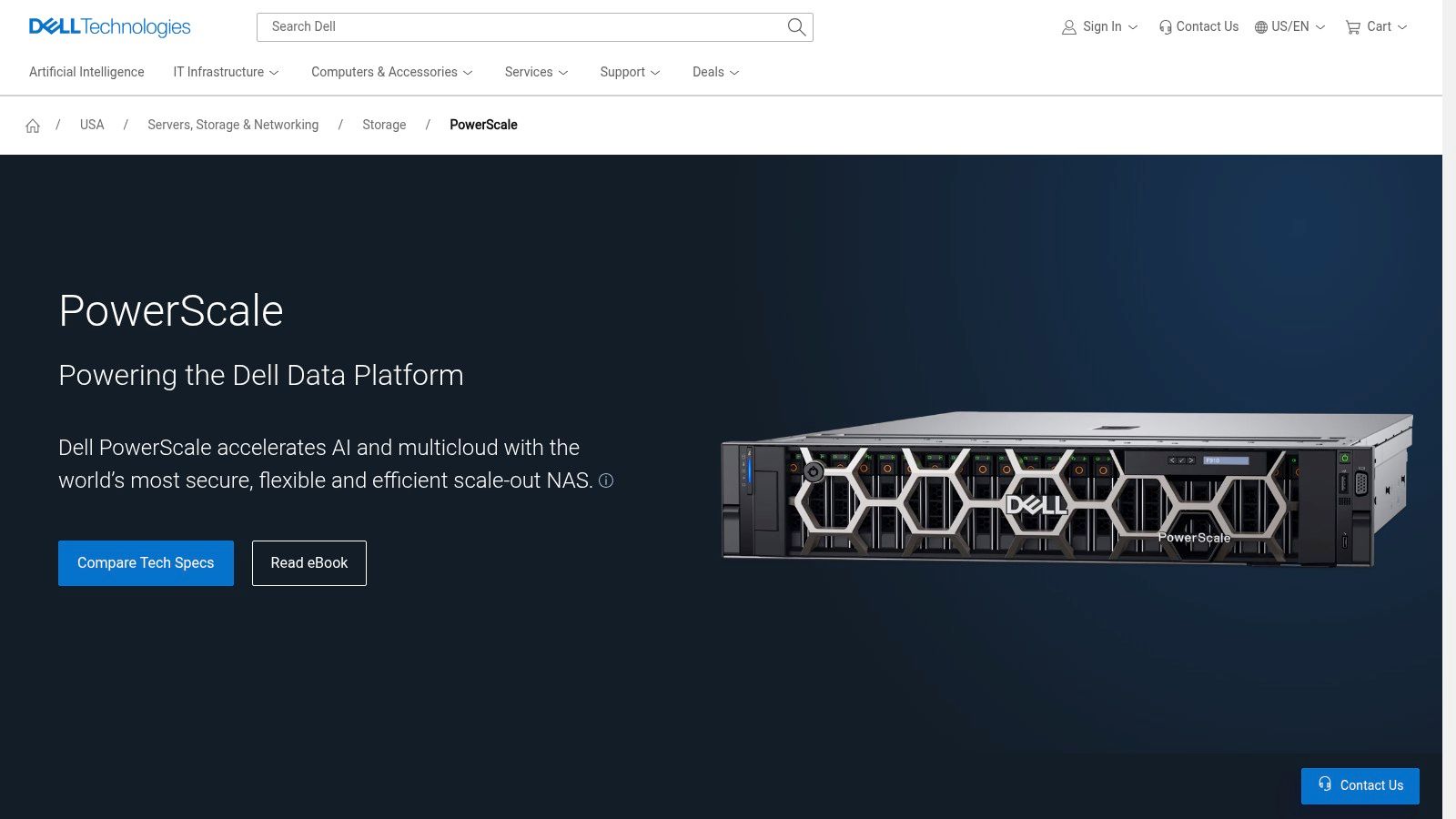
Dell EMC PowerScale (formerly Isilon) provides a robust, scalable, and performance-optimized storage solution designed for the healthcare industry. This platform addresses the need for secure and efficient management of growing volumes of medical images, clinical records, research data, and genomic information. It's a strong option for organizations prioritizing on-premises control and high performance, particularly for image-heavy workflows.
PowerScale's focus on the healthcare sector makes it a valuable tool for managing the complex and sensitive data generated within this field. Let's explore some of the key applications and benefits that make it a suitable choice for healthcare providers and researchers.
Practical Applications and Use Cases
PowerScale's versatility allows it to handle various healthcare data management needs. Here are some examples of how it can be implemented:
-
PACS Archiving and Retrieval: PowerScale's high throughput facilitates storing and quickly retrieving large medical image files, giving radiologists immediate access to vital diagnostic information.
-
VNA Consolidation: Consolidate multiple image archives into a single platform, simplifying management and improving data accessibility.
-
Genomics Research: PowerScale can manage the massive datasets generated by genomic sequencing, accelerating research and discovery.
-
EHR Data Storage: Securely store and manage sensitive patient data within Electronic Health Record (EHR) systems.
-
Clinical Trials Data Management: Provide a secure and scalable repository for clinical trial data, ensuring data integrity and compliance.
-
Medical Device Data Storage: Capture and analyze data from connected medical devices for real-time insights and better patient care.
Features and Benefits
PowerScale offers several key features and benefits that contribute to its effectiveness in healthcare settings:
-
Scalability: The scale-out Network Attached Storage (NAS) architecture allows expansion to petabytes of data, accommodating increasing healthcare information volumes.
-
Performance: Optimized for high-performance workloads like medical imaging, ensuring rapid access to critical data.
-
Multi-Protocol Access: Supporting protocols like SMB, NFS, HTTPS, SWIFT, and S3 enables flexible integration with diverse systems and applications.
-
Automated Tiering: Intelligently moves data between high-performance flash storage and more cost-effective tiers for optimized storage efficiency.
-
Data Protection: Built-in features such as snapshots and replication ensure data security and business continuity.
-
Compliance: Supports compliance with HIPAA and other healthcare regulations.
-
Cloud Integration: While primarily on-premises, PowerScale integrates with cloud storage for hybrid cloud deployments.
Pros and Cons
Like any system, PowerScale has advantages and disadvantages:
Pros:
- High performance for demanding medical imaging workflows
- Scalable architecture for growing data needs
- Robust data security and protection features
- On-premises control with cloud integration options
Cons:
- High upfront capital expenditure for hardware
- Requires dedicated physical data center space and IT management
- More complex deployment than cloud-native solutions
- Ongoing maintenance and hardware upgrade costs
Pricing and Technical Requirements
Pricing for Dell EMC PowerScale varies based on capacity, performance needs, and configuration. Contact Dell EMC for a personalized quote. Technical requirements depend on the chosen configuration; detailed specifications are available from Dell EMC.
Comparison with Similar Tools
Compared to cloud solutions like AWS S3 or Azure Blob Storage, PowerScale offers greater control and potentially higher performance on-premises, especially for low-latency data access. However, cloud solutions offer simpler deployment and scalability with a pay-as-you-go model. Compared to other on-premises solutions, PowerScale differentiates itself with its focus on healthcare workloads and features.
Implementation/Setup Tips
Here are a few tips for implementing Dell EMC PowerScale:
- Engage with Dell EMC or a certified partner for professional services.
- Plan your storage capacity needs, considering future growth.
- Develop a comprehensive data management and security strategy.
- Integrate PowerScale with your existing PACS, VNA, and EHR systems.
Website: https://www.dell.com/en-us/dt/storage/powerscale.htm
8. Hyland Healthcare
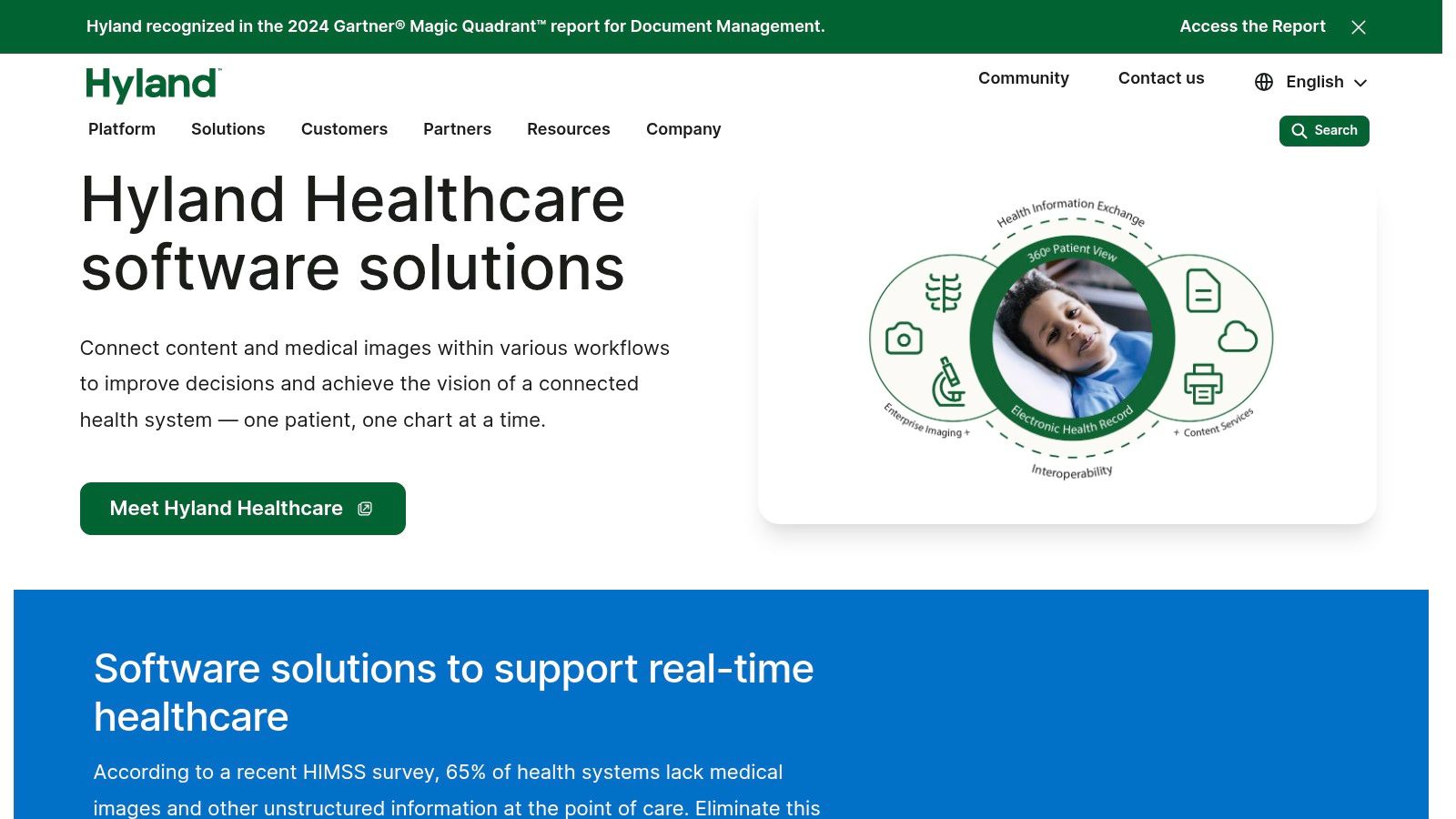
Hyland Healthcare distinguishes itself by specializing in content services and enterprise imaging solutions designed for the healthcare industry. Unlike generic storage options, Hyland offers in-depth integration with existing clinical systems. This approach addresses the complex data management needs of healthcare providers while adhering to stringent regulatory requirements. It's a compelling choice for organizations managing substantial volumes of diverse medical data.
Hyland's platform enables secure storage and access to both structured and unstructured data. This includes everything from clinical documents and medical images (including DICOM) to videos and other rich media. This centralized approach streamlines data management and promotes interoperability between different departments.
Key Features and Benefits
-
Enterprise Content Management (ECM) for Clinical Documents: Hyland's ECM streamlines the management of patient records, lab reports, and other clinical documentation. This improves workflow efficiency and reduces reliance on paper.
-
Vendor Neutral Archive (VNA): The VNA consolidates medical images from various sources into a single, accessible repository. This breaks down data silos and simplifies image sharing for better diagnostics and collaboration.
-
Clinical Workflow Automation and Integration: Key clinical processes, like document routing and image distribution, are automated, reducing manual tasks and improving turnaround times. Integration with major EHR platforms (like Epic and Cerner) further enhances workflows.
-
Advanced Security and Compliance Controls: Data security and regulatory compliance (including HIPAA and GDPR) are ensured through robust access controls, audit trails, and data encryption.
-
Integrated Viewing Capabilities: Clinicians can access and review diverse data types within a single, unified viewer. This feature simplifies data access and enhances clinical decision-making.
Pros
-
Healthcare Focus: Hyland's deep understanding of healthcare workflows and regulations sets it apart.
-
Unstructured Data Handling: The platform efficiently manages various data types, including medical images, videos, and complex content.
-
EHR Integration: Seamless integration with major EHR platforms facilitates data exchange and interoperability.
-
Comprehensive Capture and Indexing: Efficient data ingestion and retrieval are key strengths.
Cons
-
Implementation Complexity: Deploying Hyland's solutions can be complex and may require significant professional services.
-
Cost: Specialized features come at a higher price compared to general storage solutions.
-
System Architecture: Multiple product modules can add complexity to the system architecture.
-
Administration Learning Curve: Administrators require dedicated training to effectively manage the platform.
Pricing and Technical Requirements
Hyland Healthcare offers tailored pricing. Contact their sales team for details. Technical requirements vary based on chosen modules and deployment model (on-premise, cloud, or hybrid).
Comparison with Similar Tools
Hyland offers deeper healthcare system integration and better handling of medical data formats (like DICOM) than general-purpose storage. Compared to other healthcare archiving solutions, Hyland's strength lies in its comprehensive content services.
Implementation/Setup Tips
-
Define Requirements: Thoroughly assess your organization's needs before implementation.
-
Engage Professional Services: Leverage Hyland's expertise for a smooth implementation.
-
Training Plan: Provide adequate training for administrators and end-users.
Website: https://www.hyland.com/en/healthcare
9. Pure Storage FlashBlade for Healthcare
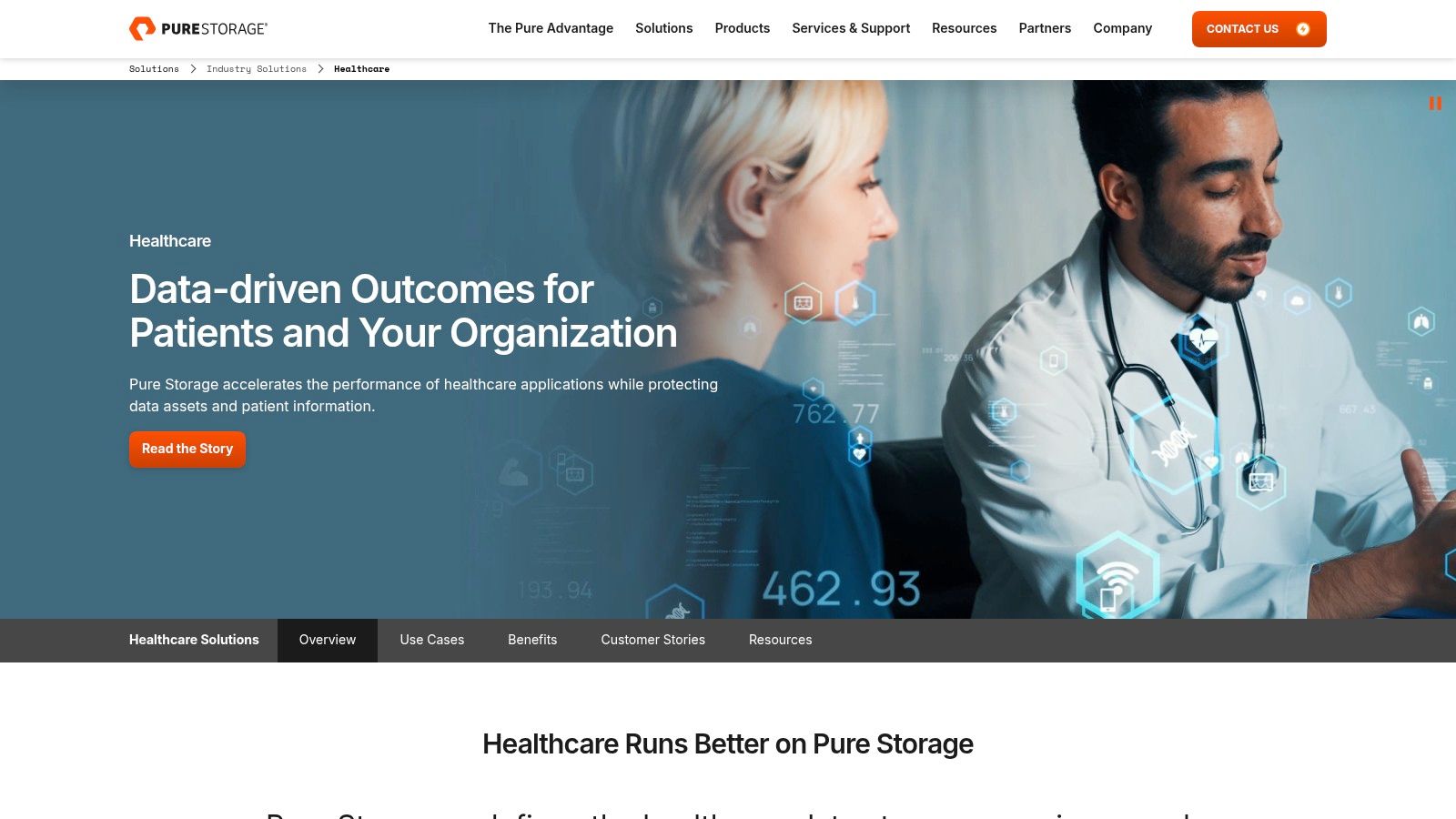
Pure Storage FlashBlade stands out as a high-performance, all-flash storage solution designed for the complex needs of modern healthcare. This platform addresses performance bottlenecks often associated with data-intensive applications. These include medical imaging, genomics sequencing, and AI-driven diagnostics. FlashBlade provides a robust solution for organizations prioritizing speed and reliability for critical patient care and research.
FlashBlade's Unified Fast File and Object storage (UFFO) architecture provides simultaneous data access via both file and object protocols. This simplifies workflows and supports a range of applications. Its massively parallel architecture enables concurrent access by many users and applications without compromising performance. This is invaluable in busy environments, such as radiology departments analyzing medical images or genomics labs processing sequencing files.
Key Features and Benefits
- All-flash performance: Optimized for low-latency requirements of medical imaging (PACS/VNA), genomics sequencing, and AI/ML model training. This leads to faster diagnoses, research results, and improved patient outcomes.
- Unified Fast File and Object Storage (UFFO): Streamlines data access and simplifies application development by offering support for both file and object storage protocols.
- Massively parallel architecture: Ensures consistent performance even under high demand, enabling efficient access for multiple users.
- Non-disruptive upgrades and expansion: Minimizes downtime and allows for seamless scaling to accommodate growing data needs.
- Built-in data protection with SafeMode snapshots: Offers strong data protection against data loss due to accidental deletion, corruption, or ransomware attacks.
Practical Applications
- Medical Imaging: Speeds up image retrieval and processing, enabling faster diagnoses and treatment planning. Supports various image formats and enhances collaboration amongst radiologists.
- Genomics Sequencing: Efficiently handles large datasets produced by next-generation sequencing, shortening analysis time and advancing research.
- AI/ML for Healthcare: Provides the performance needed for training and deploying AI models used in diagnostics, drug discovery, and personalized medicine.
- Electronic Health Records (EHR): Enables faster access to patient data, improving clinician efficiency and overall patient care.
Pros and Cons
Here's a breakdown of the advantages and disadvantages of Pure Storage FlashBlade:
| Pros | Cons |
|---|---|
| High performance for demanding applications | Higher initial investment compared to other storage options |
| Simplified management | Focus on performance, not low-cost archival |
| Predictable Evergreen subscription pricing | On-premises footprint requiring dedicated space and resources |
| Space-efficient with inline data reduction | Potential need for network upgrades (e.g., 100GbE) |
Implementation and Setup Tips
- Consult with Pure Storage experts for optimal system sizing and configuration based on your workload.
- Consider the Evergreen subscription model for predictable costs and streamlined upgrades.
- Ensure your network can handle FlashBlade's high throughput. 10/25/40/100GbE networking is recommended.
- Plan data migration and integration with your current systems.
Pricing
Pure Storage uses an Evergreen subscription model for FlashBlade. Contact them directly for specific pricing details.
Website
Pure Storage Healthcare Solutions
FlashBlade offers significant advantages for organizations that prioritize performance to accelerate data-intensive healthcare workloads. The initial investment may be higher, but the performance gains, simplified management, and predictable subscription model can deliver substantial long-term value. For those managing the increasing demands of medical data, FlashBlade is a strong option.
10. Philips HealthSuite Digital Platform
The Philips HealthSuite Digital Platform (HSDP) is a cloud-based solution designed for the complex world of healthcare data management. It serves a diverse range of users, from medical device manufacturers and researchers to hospital IT professionals. HSDP provides a secure and scalable infrastructure for storing, analyzing, and sharing sensitive patient data. Its emphasis on connected care and integration with Philips' medical devices makes it especially attractive for organizations already using Philips products.
HSDP enables data collection and analysis from many sources, including electronic health records (EHRs), medical imaging devices, wearables, and other healthcare Internet of Things (IoT) devices. This integrated approach allows for a more comprehensive understanding of patient health, giving clinicians valuable insights to improve diagnosis, treatment, and ongoing care.
Researchers, for example, can use HSDP to combine and analyze data from multiple clinical trials, speeding up the development of new therapies and devices. Hospitals can use it to improve workflows, boost operational efficiency, and implement remote patient monitoring programs.
Key Features and Benefits
-
Healthcare IoT Integration: HSDP seamlessly connects and manages data from various healthcare IoT devices, creating a centralized data repository.
-
HIPAA-Compliant Cloud Storage: Patient data security and privacy are ensured through robust security measures and compliance with HIPAA regulations. Regional data residency options are also available.
-
AI-Enabled Analytics and Clinical Decision Support: HSDP provides advanced analytics, including AI and machine learning algorithms, to extract useful insights from complex datasets and aid clinical decision-making.
-
Standardized APIs for Healthcare Application Development: Standardized APIs simplify the development and integration of custom healthcare applications, expanding the platform's functionality.
-
Medical Device Data Integration and Remote Monitoring: HSDP simplifies the integration of Philips medical devices and enables remote patient monitoring, enhancing connected care delivery.
Pros
-
Deep Healthcare Expertise: Backed by Philips' extensive experience in medical technology, the platform is designed for the specific needs of the healthcare industry.
-
Strong Support for Connected Care: HSDP facilitates connected care and remote monitoring workflows, potentially improving patient outcomes and reducing healthcare costs.
-
Comprehensive Security and Compliance: Data security and compliance with industry regulations are prioritized to protect sensitive patient information.
-
Extensive Ecosystem: HSDP offers a wide range of integrated healthcare applications and devices, particularly within the Philips product family.
Cons
-
Philips Ecosystem Focus: While offering interoperability, HSDP is optimized for the Philips ecosystem, potentially limiting flexibility for organizations using equipment from multiple vendors.
-
Less Flexible than General-Purpose Cloud Platforms: Compared to platforms like AWS or Azure, HSDP offers less flexibility for customization and integration with non-healthcare specific tools.
-
Limited Pricing Transparency: Public pricing information is scarce, and costs might be higher than more general cloud solutions. Contact Philips directly for detailed pricing.
-
Smaller Developer Community: Compared to major cloud providers, HSDP has a smaller developer community, which could limit available resources and support.
Implementation and Setup
For implementation details, it's best to contact Philips directly. Because of the platform's complexity and focus on healthcare data security, working with Philips' professional services for implementation and ongoing support is strongly recommended.
Comparison with Similar Tools
While other cloud platforms like AWS and Azure offer healthcare-specific services, HSDP stands out due to its integration with Philips' medical devices and its focus on connected care workflows. Platforms like the Google Cloud Healthcare API offer strong interoperability and data management, but HSDP's strength is in its pre-built integrations within the Philips ecosystem.
Why HSDP Deserves Its Place in the List
HSDP's comprehensive approach to healthcare data management earns it a spot on this list. Its focus on interoperability, security, and advanced analytics, combined with its tight integration within the Philips ecosystem, makes it a valuable tool for organizations aiming to use data to improve patient care and drive healthcare innovation.
Website: https://www.philips.com/a-w/about/innovation/healthsuite-digital-platform.html
Head-to-Head Medical Data Storage Comparison
| Service | Core Features ✨ | User Experience ★ | Value Proposition 💰 | Target Audience 👥 | Unique Selling Points 🏆 |
|---|---|---|---|---|---|
| Amazon Web Services Healthcare | HIPAA-ready cloud storage, scalable imaging & ML analytics | Robust ecosystem; complex configuration | Pay-as-you-go, comprehensive compliance | Large healthcare orgs, researchers | Global infrastructure with integrated services |
| Microsoft Azure Healthcare APIs | FHIR/DICOM APIs, Microsoft 365 integration, end-to-end encryption | Seamless for MS users; moderate learning curve | Interoperability with strong compliance attestations | Enterprises in Microsoft ecosystem | Deep healthcare interoperability and global standards |
| Google Cloud Healthcare API | Managed storage for FHIR, HL7v2, DICOM with AI/ML support | Advanced analytics; requires Google Cloud expertise | Scalable analytics with BigQuery integration | Data-intensive healthcare organizations | AI-powered insights built on Google’s cloud expertise |
| IBM Watson Health | Enterprise-grade data lake, AI-powered imaging & clinical analytics | Powerful but may be complex; steep learning curve | Flexible deployment options and robust analytics | Large hospitals, research centers | Watson’s cognitive capabilities tailored to healthcare |
| Salesforce Health Cloud | Unified patient data model, care gap visualization, EHR integration | Intuitive, minimal training required | Enhanced patient engagement with CRM-driven reporting | Providers focused on patient relationship management | Integrated CRM with a 360° patient view |
| Oracle Health | Integrated EHR repository with clinical imaging archive | Deep integration with clinical workflows; complex setup | Enterprise-grade reliability and end-to-end clinical solutions | Large-scale healthcare systems | End-to-end clinical workflow integration with strong domain expertise |
| Dell EMC PowerScale for Healthcare | Scale-out NAS for petabyte imaging, multi-protocol access, automated tiering | High-performance; hardware-dependent management | Exceptional on-prem performance with cloud integration options | Healthcare orgs with high imaging data needs | Optimized performance specifically for medical imaging workloads |
| Hyland Healthcare | Enterprise content management, VNA for medical images & documents | Seamless clinical system integration; requires professional setup | Specialized solution for unstructured data with compliance benefits | Hospitals needing integrated content management | Robust capture and indexing with deep clinical workflow automation |
| Pure Storage FlashBlade for Healthcare | All-flash storage optimized for imaging & genomics, unified file/object storage | Simple, fast management; on-prem footprint | Predictable subscription pricing with exceptional performance | Organizations with data-intensive AI/ML workloads | High-speed performance with inline data reduction |
| Philips HealthSuite Digital Platform | Cloud-based IoT integration, secure storage with advanced analytics | Integrated device connectivity; secure, modern UI | Comprehensive management across clinical and operational settings | Providers emphasizing connected and remote care | Trusted medical tech expertise with unified data & device integration |
Choosing the Right Medical Data Storage Solution
Selecting the right medical data storage solution can feel overwhelming with so many options available. A strategic approach is essential. Key factors to consider include data volume and velocity, security and compliance requirements (like HIPAA and GDPR), integration with current systems, budget, and future scalability. The many solutions available—from established cloud providers like AWS, Azure, and Google Cloud to specialized platforms like Hyland Healthcare and Philips HealthSuite—offer diverse approaches to managing healthcare data. Each caters to specific needs, highlighting the importance of a thorough evaluation.
Key Considerations for Choosing a Solution
When comparing solutions, carefully evaluate the following:
-
Data Volume and Type: Consider the types of data you work with. Do you primarily handle DICOM images, genomic data, EHR records, or a mix? Some solutions are optimized for specific data types.
-
Security and Compliance: Robust security and compliance certifications are crucial. Ensure the solution adheres to all regulatory requirements, such as HIPAA and GDPR, relevant to your region and data types.
-
Integration and Interoperability: Seamless integration with your existing EHR, PACS, and other healthcare systems is vital for workflow efficiency. Carefully assess API availability and compatibility.
-
Scalability and Performance: Your chosen solution should manage your current data volume and scale to accommodate future growth without performance issues.
-
Cost and Resource Allocation: Consider the total cost of ownership. This includes storage fees, implementation, maintenance, and potential training. Evaluate your in-house resources and determine if external support is needed.
Implementation and Planning
Implementing your chosen solution typically involves several steps: data migration, system configuration, and staff training. Thorough planning and collaboration with your vendor will streamline the process. A pilot project, testing the solution in a controlled environment before full deployment, is highly recommended.
Budget and Resources
Budget and resource allocation are paramount. Cloud-based solutions often provide flexible pricing models. On-premise solutions require upfront investment in hardware and infrastructure. Factor in ongoing maintenance, security updates, and potential data recovery services.
Integration and Compatibility
Seamless data flow requires focusing on integration and compatibility. The chosen solution must integrate with existing systems and support standard healthcare data formats like HL7, FHIR, and DICOM. This interoperability minimizes data silos and promotes efficient collaboration.
Choosing the Right Solution
Choosing the right medical data storage solution requires a comprehensive assessment of your organization's specific needs and priorities. Carefully considering data volume, security, integration, scalability, budget, and resources ensures a solution that effectively manages your data, improves patient care, and supports innovation.
Ready to enhance your medical imaging capabilities with AI? PYCAD offers comprehensive solutions for data handling, model training, and deployment, empowering you to optimize medical devices and improve diagnostic accuracy. From data annotation and anonymization to deploying trained models as APIs and creating MVP UIs, PYCAD provides robust support. Partner with us to unlock the potential of your medical data and drive impactful healthcare outcomes. Learn more at https://pycad.co.

